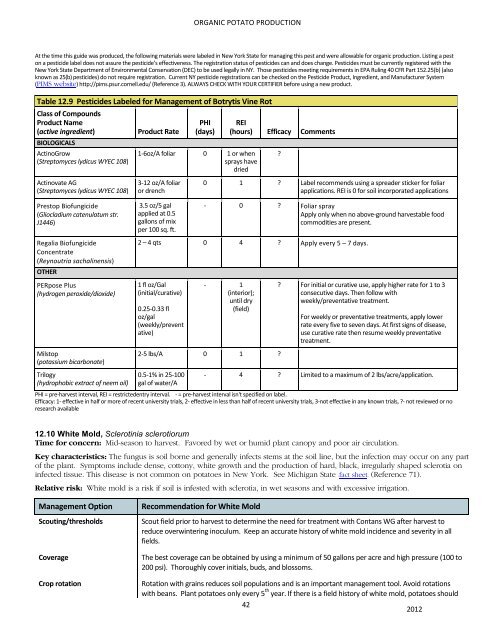potato 5-9-12 CLEAN - Vegetableipmasia.org
potato 5-9-12 CLEAN - Vegetableipmasia.org
potato 5-9-12 CLEAN - Vegetableipmasia.org
You also want an ePaper? Increase the reach of your titles
YUMPU automatically turns print PDFs into web optimized ePapers that Google loves.
ORGANIC POTATO PRODUCTION At the time this guide was produced, the following materials were labeled in New York State for managing this pest and were allowable for <strong>org</strong>anic production. Listing a pest on a pesticide label does not assure the pesticide’s effectiveness. The registration status of pesticides can and does change. Pesticides must be currently registered with the New York State Department of Environmental Conservation (DEC) to be used legally in NY. Those pesticides meeting requirements in EPA Ruling 40 CFR Part 152.25(b) (also known as 25(b) pesticides) do not require registration. Current NY pesticide registrations can be checked on the Pesticide Product, Ingredient, and Manufacturer System (PIMS website) http://pims.psur.cornell.edu/ (Reference 3). ALWAYS CHECK WITH YOUR CERTIFIER before using a new product. Table <strong>12</strong>.9 Pesticides Labeled for Management of Botrytis Vine Rot Class of Compounds Product Name (active ingredient) BIOLOGICALS ActinoGrow (Streptomyces lydicus WYEC 108) Actinovate AG (Streptomyces lydicus WYEC 108) Product Rate PHI (days) 1-‐6oz/A foliar 0 1 or when sprays have dried 3-‐<strong>12</strong> oz/A foliar or drench Prestop Biofungicide 3.5 oz/5 gal (Gliocladium catenulatum str. J1446) applied at 0.5 gallons of mix per 100 sq. ft. Regalia Biofungicide Concentrate (Reynoutria sachalinensis) OTHER PERpose Plus (hydrogen peroxide/dioxide) Milstop (potassium bicarbonate) Trilogy (hydrophobic extract of neem oil) REI (hours) Efficacy Comments ? 0 1 ? Label recommends using a spreader sticker for foliar applications. REI is 0 for soil incorporated applications -‐ 0 ? Foliar spray Apply only when no above-‐ground harvestable food commodities are present. 2 – 4 qts 0 4 ? Apply every 5 – 7 days. 1 fl oz/Gal (initial/curative) 0.25-‐0.33 fl oz/gal (weekly/preventative) -‐ 1 (interior); until dry (field) 2-‐5 lbs/A 0 1 ? 0.5-‐1% in 25-‐100 gal of water/A ? For initial or curative use, apply higher rate for 1 to 3 consecutive days. Then follow with weekly/preventative treatment. For weekly or preventative treatments, apply lower rate every five to seven days. At first signs of disease, use curative rate then resume weekly preventative treatment. -‐ 4 ? Limited to a maximum of 2 lbs/acre/application. PHI = pre-‐harvest interval, REI = restrictedentry interval. -‐ = pre-‐harvest interval isn't specified on label. Efficacy: 1-‐ effective in half or more of recent university trials, 2-‐ effective in less than half of recent university trials, 3-‐not effective in any known trials, ?-‐ not reviewed or no research available <strong>12</strong>.10 White Mold, Sclerotinia sclerotiorumTime for concern: Mid-season to harvest. Favored by wet or humid plant canopy and poor air circulation.Key characteristics: The fungus is soil borne and generally infects stems at the soil line, but the infection may occur on any partof the plant. Symptoms include dense, cottony, white growth and the production of hard, black, irregularly shaped sclerotia oninfected tissue. This disease is not common on <strong>potato</strong>es in New York. See Michigan State HUfact sheetUH (Reference 71).Relative risk: White mold is a risk if soil is infested with sclerotia, in wet seasons and with excessive irrigation.Management Option Scouting/thresholds Coverage Crop rotation Recommendation for White Mold Scout field prior to harvest to determine the need for treatment with Contans WG after harvest to reduce overwintering inoculum. Keep an accurate history of white mold incidence and severity in all fields. The best coverage can be obtained by using a minimum of 50 gallons per acre and high pressure (100 to 200 psi). Thoroughly cover initials, buds, and blossoms. Rotation with grains reduces soil populations and is an important management tool. Avoid rotations with beans. Plant <strong>potato</strong>es only every 5 th year. If there is a field history of white mold, <strong>potato</strong>es should 4220<strong>12</strong>




![Section 4 [ PDF file, 252 KB] - The Field Alliance](https://img.yumpu.com/51387260/1/158x260/section-4-pdf-file-252-kb-the-field-alliance.jpg?quality=85)











